- Books Name
- AMARENDRA PATTANAYAK Mathmatics Book
- Publication
- KRISHNA PUBLICATIONS
- Course
- CBSE Class 11
- Subject
- Mathmatics
Special Types of Functions
- Constant Function
- Identity Function
- Polynomial function
- Linear Function
- Identical Function
- Quadratic Function
- Rational Function
- Algebraic Functions
- Cubic Function
- Modulus Function
- Signum Function
- Greatest Integer Function
- Smallest Integer Function
- Step Function
- Characteristics Function
- Indicator Function
- Fractional Part Function
- Exponential Function
- Logarithmic Function
- Sinusoidal. Function
- Even and Odd Function
- Periodic Function
- Composite Function
Polynomial function
A real valued function f : P → P defined by y = f (a)=h0+h1 a+…..+hn an, where n ϵ N, and h0+h1+…..+hn ϵ P, for each a ϵ P, is called polynomial function.
- N = a Natural Number.
- The degree of Polynomial function is the highest power in the expression.
- If the degree is zero, it’s called a constant function.
- If the degree is one, it’s called a linear function. Example: b = a+1.
- Graph type: Always a straight line.
So, a polynomial function can be expressed as :
f(x)=anxn+an−1xn−1+…..+a1x1+a0
The highest power in the expression is known as the degree of the polynomial function. The different types of polynomial functions based on the degree are:
- The polynomial function is called a Constant function if the degree is zero.
- The polynomial function is called a Linear if the degree is one.
- The polynomial function is Quadratic if the degree is two.
- The polynomial function is Cubic if the degree is three.
Linear Function
All functions in the form of ax + b where a, b∈R & a ≠ 0 are called as linear functions. The graph will be a straight line. In other words, a linear polynomial function is a first-degree polynomial where the input needs to be multiplied by m and added to c. It can be expressed by f(x) = mx + c.
For example, f(x) = 2x + 1 at x = 1
f(1) = 2.1 + 1 = 3
f(1) = 3
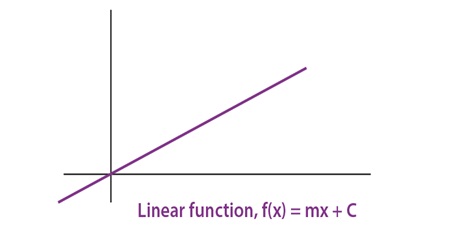
Another example of linear function is y = x + 3
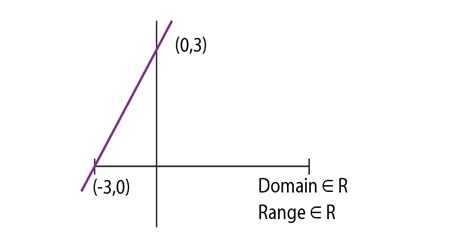
Identical Function
Two functions f and g are said to be identical if
(a) The domain of f = domain of g
(b) The range of f = the Range of g
(c) f(x) = g(x)∀ x∈Df & Dg
For example f(x) = x & g(x) =11/x
Solution: f(x) = x is defined for all x
But g(x) = 11/x is not defined of x = 0
Hence it is identical for x ∈R -{0}
Quadratic Function
All functions in the form of y = ax2 + bx + c where a, b, c∈R, a ≠ 0 will be known as Quadratic function. The graph will be parabolic.

At x=−b±D2, we will get its maximum on minimum value depends on the leading coefficient and that value will be −D4a (where D = Discriminant)
In simpler terms,
A Quadratic polynomial function is a second degree polynomial and it can be expressed as;
F(x) = ax2 + bx + c, and a is not equal to zero.
Where a, b, c are constant and x is a variable.
Example, f(x) = 2x2 + x – 1 at x = 2
If x = 2, f(2) = 2.22 + 2 – 1 = 9
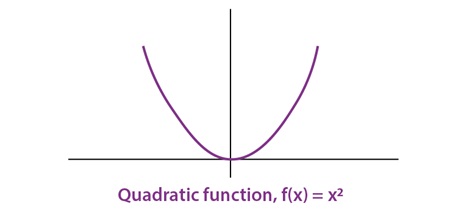
For Example: y = x2 + 1
Read More: Quadratic Function Formula
Rational Function
These are the real functions of the type f(a)g(a) where f (a) and g (a) are polynomial functions of a defined in a domain, where g(a) ≠ 0.
- For example f : P – {– 6} → P defined by f (a) = f(a+1)g(a+2), ∀aϵP – {–6 }is a rational function.
- Graph type: Asymptotes (the curves touching the axes lines).
Algebraic Functions
A function that consists of a finite number of terms involving powers and roots of independent variable x and fundamental operations such as addition, subtraction, multiplication, and division is known as an algebraic equation.
For Example,
f(x)=5x3−2x2+3x+6, g(x)=3x+4(x−1)2.
Cubic Function
A cubic polynomial function is a polynomial of degree three and can be expressed as;
F(x) = ax3 + bx2 + cx + d and a is not equal to zero.
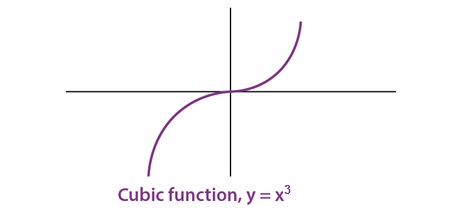
In other words, any function in the form of f(x) = ax3 + bx2 + cx + d, where a, b, c, d∈R & a ≠ 0

For example: y = x3
MODULUS FUNCTION:
A Function f(x) : R à R is said to be Modulus function if y=f(x) = |x|

Domain of f = R
Range of f = R+U {0}
Codomain=R
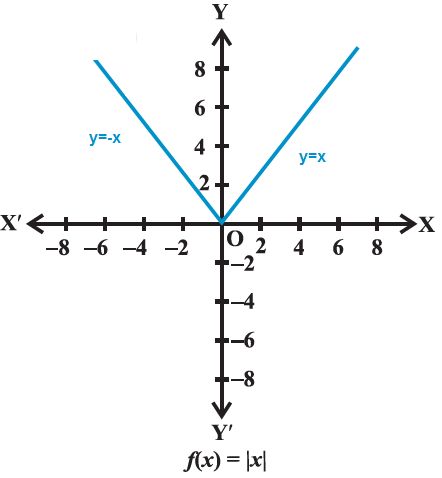
If x = -5, then y = f(x) = – (-5) = 5, since x is less than zero
If x = 10, then y = f(x) = 10, since x is greater than zero
If x = 0, then y = f(x) = 0, since x is equal to zero
When x = -3 then y = |-3| = 3
When x = -2 then y = |-2| = 2
When x = -1 then y = |-1| = 0
When x = 0 then y = |0| = 0
When x = 1 then y = |1| = 1
When x = 2 then y = |2| = 2
When x = 3 then y = |3| = 3
Signum Function:
A Function f(x) : R à R is said to be signum function if 
Domain of f = R
Range of f = {-1,0,1}
Codomain=R
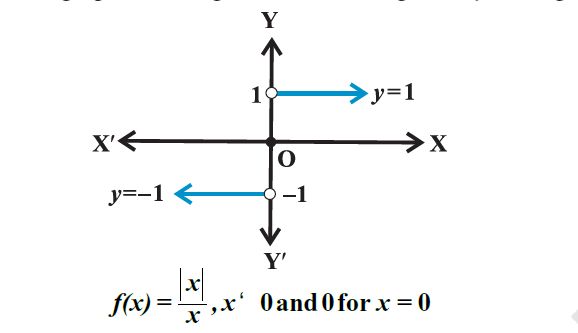
If x = -5, then y = f(x) = – 1 , since x is less than zero
If x = 5, then y = f(x) = 1 , since x is greater than zero
If x = 0, then y = f(x) = 0 , since x is equal to zero
Greatest Integer Function:
A Function f(x) : R à R is said to be greatest integer function if y=f(x)=[x]
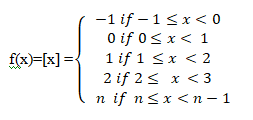
or
The function f: R , R defined by f(x) = [x], x R assumes the value of the greatest integer, less
than or equal to x. Such a function is called the greatest integer function.
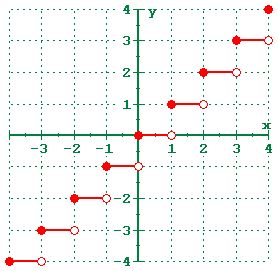
Domain of f = R
Range of f = Z
Codomain=R
[1.15] = 1 , [1.9] =1
[4.56567] = 4 , [4.99] = 4
[50] = 50
[-3.010] = -4
Greatest Integer Function Properties
- [x] = x, where x is an integer
- [x + n] = [x] + n, where n ∈ Z
- [-x] = –[x], if x ∈ Z
- [-x] =-[x] – 1, if x ∉ Z
- If [f(x)] ≥ Y, then f(x) ≥ Y
Smallest Integer Function:
Ceiling function f(x) = ⌈x⌉ and floor function f(x)=⌊x ⌋
f(x) = ⌊x⌋ = Largest Nearest Integer of specified value
f(x) = ⌈x⌉ = Least Nearest successive Integer of specified value
A Function f(x) : R à R is said to be Smallest integer function if y=f(x)= ⌊x ⌋
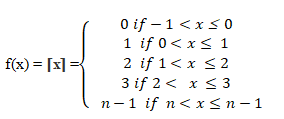
Domain of f = R
Range of f = Z
Codomain=R
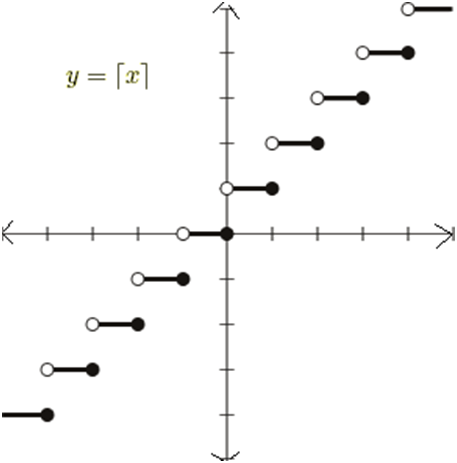
Properties:
- ⌈x⌉ + ⌈y⌉ – 1 ≤ ⌈x + y⌉ ≤ ⌈x⌉ + ⌈y⌉
- ⌈x + a⌉ = ⌈x⌉ + a
- ⌈x⌉ = a; iff x ≤ a < x + 1
- ⌈x⌉ = a; iff x – 1 < a ≤ x
- a < ⌈x⌉ iff a < x
- a ≤ ⌈x⌉ iff x < a
Step Function:
A step function (also called as staircase function) is defined as a piecewise constant function, that has only a finite number of pieces. In other words, a function on the real numbers can be described as a finite linear combination of indicator functions of given intervals.
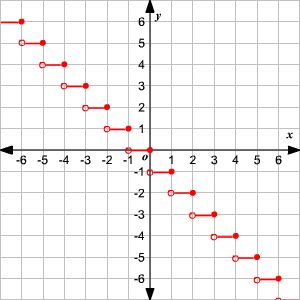
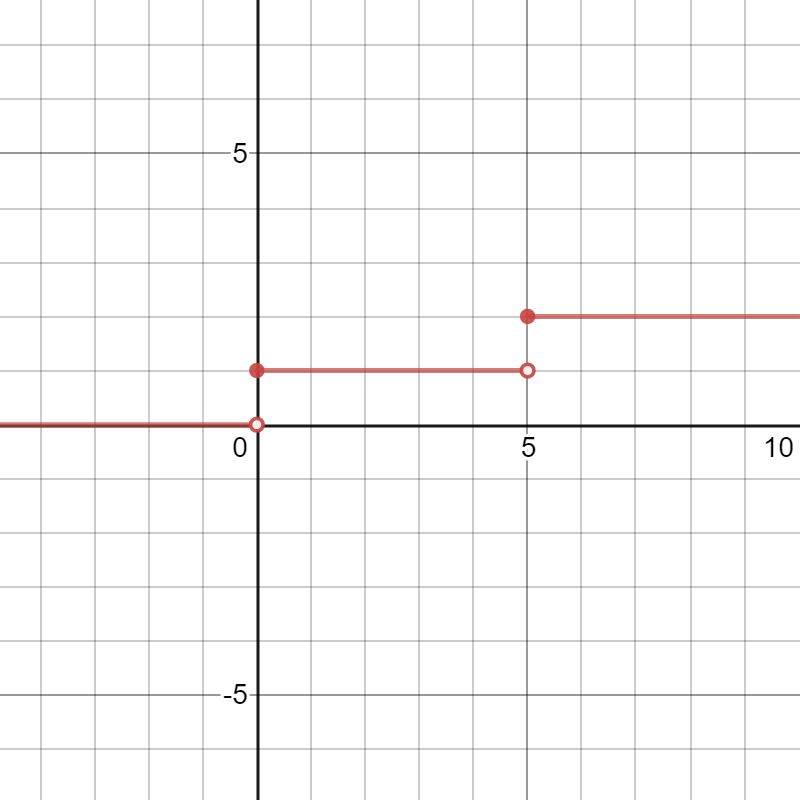
Domain of f = referred to as the set of input values
Range of f = referred to as the set of output values generated for the domain (input values)
Properties
The important properties of step functions are given below:
- The sum or product of two-step functions is also a step function.
- If a step function is multiplied by a number, then the result produced is again a step function. That indicates the step functions create an algebra over the real numbers
- A step function can take only a finite number of values
- Piecewise linear function is the definite integral of a step function
Indicator function / Characteristic function:
An indicator function or a characteristic function of a subset of a set is a function that maps elements of the subset to one, and all other elements of the set to zero. The indicator function of a subset A of a set X maps X to the two-element set
{ 0,1}; cA(x)=1 if an element in X belongs to A
and cA(x)=0 if x does not belong to A.
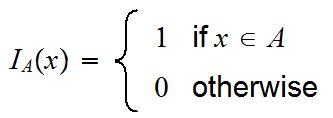
It may be denoted as 1A , by IA or by cA
The indicator function of a subset, that is the function
c A : X à {0,1}
which for a given subset A of X, has value 1 at points of A and 0 at points of X − A.
Fractional Part Function:
The fractional part function is the difference between a number and its integer part.
A Function f(x) : R à R is said to be fractional part function if y = f(x) = {x} = x- [x]
Domain of a fractional function is all the real numbers except the roots of denominator of the fraction.
Codomain =R
Range = [0,1)
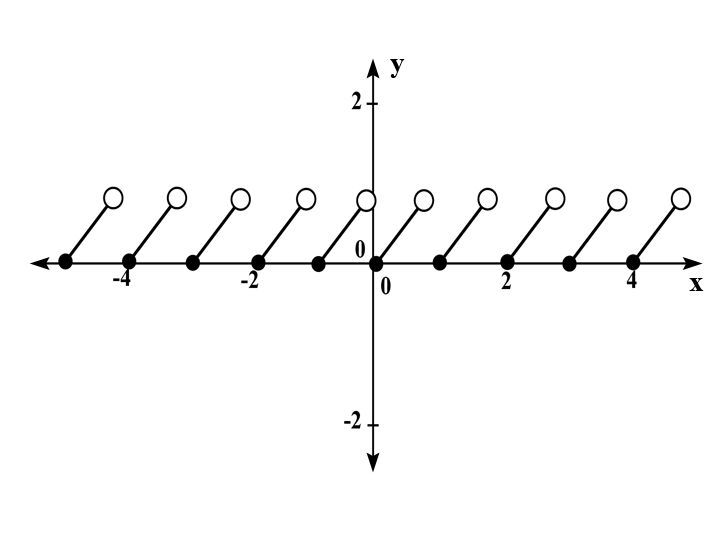
{1}=1−[1]=1-1=0.
Properties;

Exponential Function:
For a > 1, the Exponential of b to base a is x if y =f(x)= ax = b. Thus, The function is known as Exponential function
Exponential function having base 10 is known as a common exponential function.
i.e.,y=f(x)= 10x
Exponential function having base e is known as a Natural exponential function.
y=f(x)= ex
Domain =R
Codomain =R+
Range = R+
Properties:
- The graph passes through the point (0,1).
- The domain is all real numbers
- The range is y>0
- The graph is increasing
- The graph is asymptotic to the x-axis as x approaches negative infinity
- The graph increases without bound as x approaches positive infinity
- The graph is continuous
- The graph is smooth
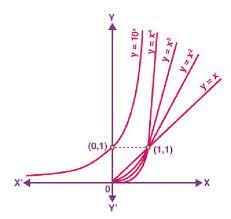
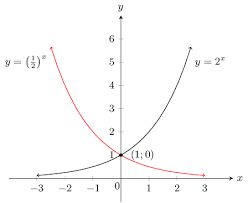
If a>0, and b>0, the following hold true for all the real numbers x and y:
-
- ax ay = ax+y
- ax/ay = ax-y
- (ax)y = axy
- axbx=(ab)x
- (a/b)x= ax/bx
- a0=1
- a-x= 1/ ax
Logarithmic Function:
For a > 1, the logarithm of b to base a is x if ax = b. Thus, loga b = x if ax = b. This function is known as logarithmic function.
logarithm function having base 10 is known as a common logarithm function.
i.e.,y=f(x)= log10 x
logarithm function having base e is known as a Natural logarithm function.
y=f(x)= loge x= lnx
Domain = R+
Codomain =R
Range = R
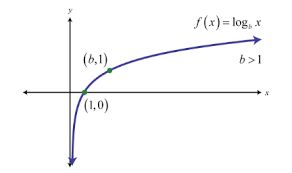
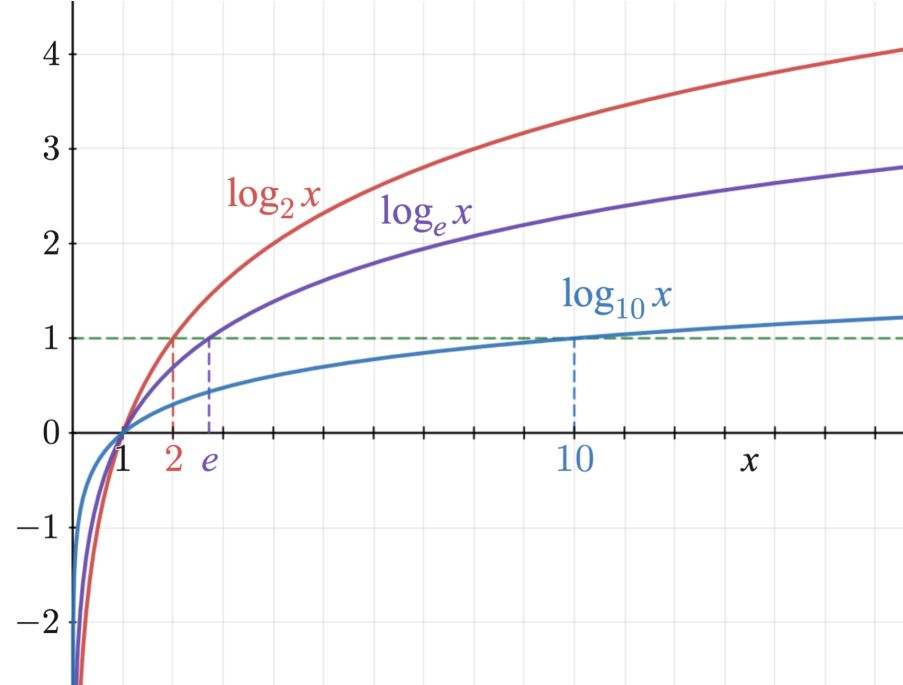
Properties:
- The graph passes through the point (1,0).
- The domain is all +ve real numbers
- Logap = α, logbp = β and logba = µ, then aα = p, bβ = p and bµ = a
- Logbpq = Logbp + Logbq
- Logbpy = ylogbp
- Logb (p/q) = logbp – logbq
- When we plot the graph of log functions and move from left to right, the functions show increasing behaviour.
- The graph of log function never cuts the x-axis or y-axis, though it seems to tend toward them.
Sinusoidal Function:
A sinusoidal function is a function using the sine function. The basic form of a sinusoidal function is ![]() where A is the amplitude or height of our function, B is the change in period defined by
where A is the amplitude or height of our function, B is the change in period defined by ![]() the horizontal shift, and D the vertical shift.
the horizontal shift, and D the vertical shift.
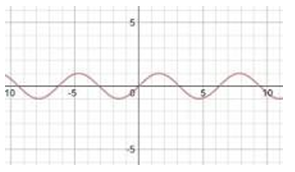
The sine and cosine functions have several distinct characteristics:

Even and Odd Function:
The definition of even and odd functions:
Even function: A function, f(x) is even if f(x) = f(-x)
Example:f(x)=cosx
f(-x)=cos(-x)= cosx=f(x)
so f is even function.
examples of even functions are x4, cot x, y = x2, etc.
Odd Function: A function, f(x) is odd if f(x) = -f(x) For example,
Check if function is even or odd: f (x) = tan x
f(-x)=tan(-x)= -tanx=-f(x)
so f is odd function.
The polynomial function f(x)=x2+x4+x6 is even. The polynomial function f(x)=x+x3+x5 is odd
Periodic Function:
A function y= f(x) is said to be a periodic function if there exists a positive real number P such that f(x + P) = f(x), for all x belongs to real numbers. The least value of the positive real number P is called the fundamental period of a function.
This fundamental period of a function is also called the period of the function, at which the function repeats itself. f(x + P) = f(x)
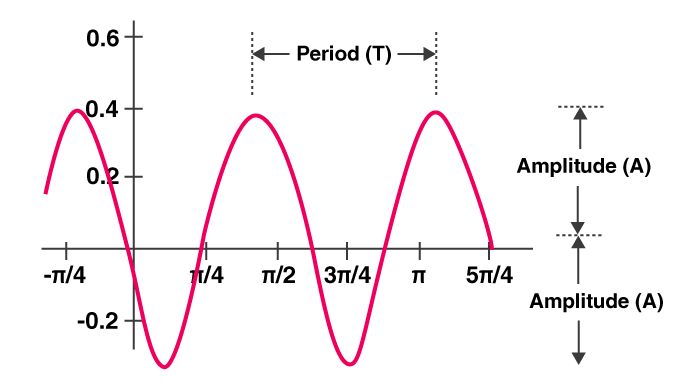
The period of the sine ,cosine function is 2π (units). All the trigonometric functions are periodic functions.
Composite Function:
Let f : A → B and g : B → C be two functions. Then the composition of f and g, denoted by g ∘ f, is defined as the function g ∘ f : A → C given by g ∘ f (x) = g(f (x)), ∀ x ∈ A.
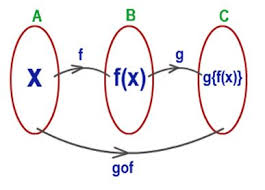
The composite function gof(x) is read as “g of f of x”. If f(x)and g(x) are two functions then fog(x), gof(x), gog(x) and fof(x) are composite functions.
- fog(x) = f(g(x))
- gof(x) = g(f(x))
- gog(x) = g(g(x))
- fof(x) = f(f(x))
- fogoh(x) = f(g(h(x)))
- fofof(x) = f(f(f(x)))
The order of the function is important in a composite function since (fog)(x) is not equal to (gof)(x).
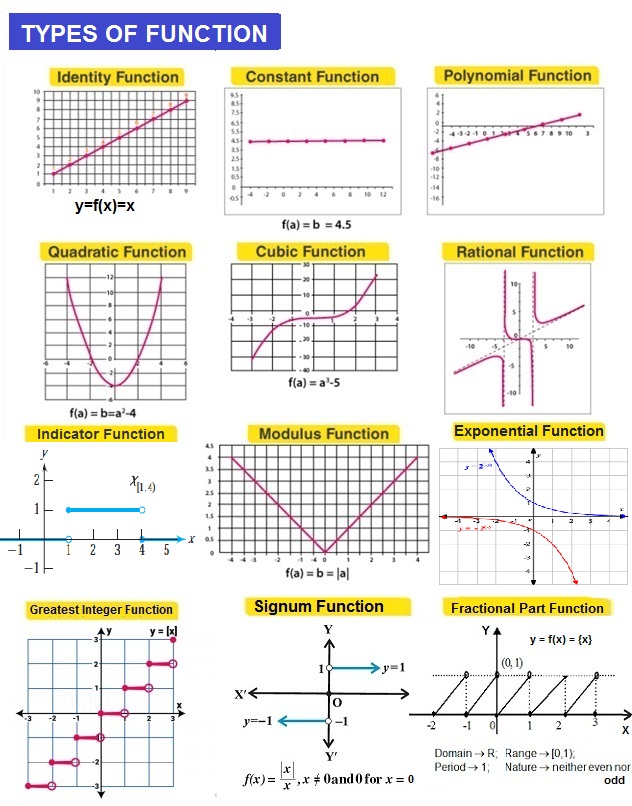

 KRISHNA PUBLICATIONS
KRISHNA PUBLICATIONS
